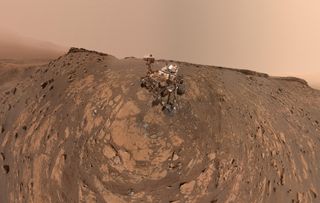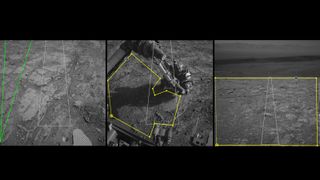NASA needs your help teaching its Curiosity rover how to drive on Mars

NASA is asking for your help to guide its Curiosity rover around sand traps, sharp rocks and other obstacles on the Red Planet.
A new online tool called AI4Mars, hosted on Zooniverse, allows anyone to label parts of the terrain in the landscape surrounding Curiosity, which has been roving on Mars since 2012.
The tool is a form of "machine learning" that allows rover planners assisting with Curiosity's movements to train the rover's intelligence for safe route planning. Picking an appropriate pathway is a pressing problem for Martian rovers. Curiosity's wheels wore down in the early years of its mission from driving over sharp rocks, while another Mars rover called Spirit got permanently stuck in a sand trap in 2010.
Related: How do you drive a Mars rover from home?

The first stage of training the algorithm, called SPOC (short for "Soil Property and Object Classification"), will allow it to distinguish between different types of terrain. SPOC is already used by Martian rover drivers, but bringing in the public will provide more training information at a faster pace. Curiosity's challenges are distinct from the self-driving car algorithms available, for example, as the rover isn't working with roads, pedestrians or traffic signs. So more help is needed to get the algorithm trained quickly.
"In the future, we hope this algorithm can become accurate enough to do other useful tasks, like predicting how likely a rover's wheels are to slip on different surfaces," Hiro Ono, an artificial intelligence researcher at NASA's Jet Propulsion Laboratory (JPL) in Pasadena, California, said in a statement.
A typical rover drive takes about four to five hours to plan, including several people writing and reviewing hundreds of lines of code, JPL said in the statement. Coders aren't the only ones involved in the process. Geologists look at the terrain for safety issues, planners make sure the rover's high-gain antenna has a clear line of sight to Earth so the rover can communicate with mission control, and teams also consider how shadows may interfere with the rover's distance measurements. (Curiosity uses visual odometry, a technique that compares camera images to landmarks in the vicinity, so shadows can make the process more difficult, NASA said.)
Get the Space.com Newsletter
Breaking space news, the latest updates on rocket launches, skywatching events and more!
"It's our job to figure out how to safely get the mission's science," Stephanie Oij, one of the JPL rover planners involved in AI4Mars, said in the same statement. "Automatically generating terrain labels would save us time and help us be more productive."
Curiosity's training will also give a boost to the Perseverance rover, which is expected to launch no earlier than July 20 for a landing on Mars in 2021. More than 8,000 Curiosity images are available on the AI4Mars site already, allowing the public to start labeling images to help Curiosity and eventually, Perseverance.
Images from the Mars Exploration Rovers Spirit and Opportunity — who have both ended their missions — may be available on AI4Mars in the future, Ono added. More languages are also expected shortly on AI4Mars to assist volunteers, including Spanish, Hindi and Japanese.
- NASA has big plans for AI on Mars and beyond
- Photos: Spectacular Mars vistas by NASA's Curiosity rover
- See Earth and Venus from Mars in amazing photos from NASA's Curiosity rover
Follow Elizabeth Howell on Twitter @howellspace. Follow us on Twitter @Spacedotcom and on Facebook.
OFFER: Save 45% on 'All About Space' 'How it Works' and 'All About History'!
For a limited time, you can take out a digital subscription to any of our best-selling science magazines for just $2.38 per month, or 45% off the standard price for the first three months.
Join our Space Forums to keep talking space on the latest missions, night sky and more! And if you have a news tip, correction or comment, let us know at: community@space.com.

Elizabeth Howell (she/her), Ph.D., is a staff writer in the spaceflight channel since 2022 specializing in Canadian space news. She was contributing writer for Space.com for 10 years before joining full-time. Elizabeth's reporting includes multiple exclusives with the White House, speaking several times with the International Space Station, witnessing five human spaceflight launches on two continents, flying parabolic, working inside a spacesuit, and participating in a simulated Mars mission. Her latest book, "Why Am I Taller?" (ECW Press, 2022) is co-written with astronaut Dave Williams.
-
JPL-ACE The article points to Zoonivers to help but there is nothing on Zooni like AI4Mars . By searching for it on google I found this.Reply
https://www.zooniverse.org/projects/hiro-ono/ai4mars/about/faq
Looks like this site edits mu URL so try googling https://www.zooniverse.org/projects/hiro-ono/ai4mars/about/faq
